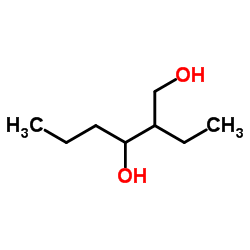Etohexadiol

Etohexadiol structure
|
Common Name | Etohexadiol | ||
|---|---|---|---|---|
| CAS Number | 94-96-2 | Molecular Weight | 146.227 | |
| Density | 0.9±0.1 g/cm3 | Boiling Point | 243.0±8.0 °C at 760 mmHg | |
| Molecular Formula | C8H18O2 | Melting Point | -40 °C | |
| MSDS | Chinese USA | Flash Point | 129.4±0.0 °C | |
| Symbol |


GHS05, GHS07 |
Signal Word | Danger | |
|
Comparative sensitivity of four Anopheles (Diptera: Culicidae) to five repellents.
J. Med. Entomol. 28(3) , 417-20, (1991) Five repellents were evaluated against Anopheles albimanus Wiedemann An. freeborni Aitken, An. gambiae Giles, and An. stephensi Liston, using a "free choice," dose-response testing procedure on rabbits. Overall, deet was the most effective repellent based on ... |
|
|
The acute toxicity and primary irritancy of 2-ethyl-1,3-hexanediol.
Vet. Hum. Toxicol. 27(6) , 491-5, (1985) 2-Ethyl-1,3-hexanediol (EHD), an insect repellant, was found to have acute peroral LD50 values in the rat of 9.85 ml/kg (males) and 4.92 ml/kg (females). Acute percutaneous LD50 values in the rabbit were 10.8 ml/kg (males) and 9.51 ml/kg (females). There were... |
|
|
Prevention of Lyme disease.
Am. J. Hosp. Pharm. 49(5) , 1164-73, (1992) Lyme disease and the use of tick repellents and physical protective measures to prevent the disease are discussed. Lyme disease is a multiple-organ-system, immune-mediated inflammatory disorder transmitted by the bites of ixodid ticks infected with Borrelia b... |
|
|
Intralaboratory and interlaboratory evaluation of the EpiDerm 3D human reconstructed skin micronucleus (RSMN) assay.
Mutat. Res. 673(2) , 100-8, (2009) A novel in vitro human reconstructed skin micronucleus (RSMN) assay has been developed using the EpiDerm 3D human skin model [R. D. Curren, G. C. Mun, D. P. Gibson, and M. J. Aardema, Development of a method for assessing micronucleus induction in a 3D human ... |
|
|
Pharmacokinetics of 2-ethyl-1,3-hexanediol. III. In vitro skin penetration comparisons using the excised skin of humans, rats, and rabbits.
Fundam. Appl. Toxicol. 28(1) , 1-8, (1995) Excised skin from Fischer 344 rats, New Zealand White rabbits, and human females (obtained from mammoplasty patients) were compared for their in vitro skin penetration potential with 2-[14C]-ethyl-1,3-hexanediol (EHD). EHD was applied as both an undiluted dos... |
|
|
Repeated exposure toxicity of 2-ethyl-1,3-hexanediol by cutaneous applications to the rat for 9 and 90 days.
Vet. Hum. Toxicol. 37(1) , 33-6, (1995) 2-Ethyl-1,3-hexanediol (EHD; CASRN 94-96-2), an industrial chemical and insect repellent, has a high potential for recurrent skin contact. Short-term (9 d) and subchronic (13 w) repeated epicutaneous contact studies were conducted to determine the potential f... |
|
|
Tests of repellents against Diamanus montanus (Siphonaptera: Ceratophyllidae).
J. Med. Entomol. 19(4) , 361-5, (1982)
|
|
|
In vitro and in vivo evaluation of the genotoxic potential of 2-ethyl-1,3-hexanediol.
Toxicology 53(2-3) , 179-98, (1988) 2-Ethyl-1,3-hexanediol (EHD) has intentional human exposure because of its application to skin as an insect repellent and its use in various skin care products. Genotoxicity studies on EHD were conducted to determine mutagenic and clastogenic potential using ... |
|
|
[Efficacy of the combination of DEET (20%) and EHD (15%) against mosquito bites. Results of a study carried out in Senegal].
Bull. Soc. Pathol. Exot. Filiales 94(3) , 280-3, (2001) The authors report the results of a survey on the efficacy against mosquito bites of a repellent, Mousticologne Spécial Zones Infestées (DEET 20%, EHD 15%). Two forms of the product, spray and gel, were tested in Senegal. Repellent efficacy was evaluated by e... |
|
|
Attraction of mosquitoes to diethyl methylbenzamide and ethyl hexanediol.
J. Am. Mosq. Control Assoc. 6(3) , 469-76, (1990) Studies by prior workers have shown that insect repellents can act as attractants when present as low concentrations, deposits or residues. In the present study deet and ethyl hexanediol were tested in 2-fold serial doses from 1.9 X 10(-9) to 1.6 X 10(-2) mg/... |